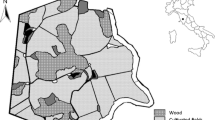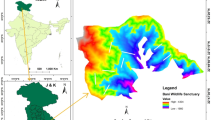Abstract
Abstract Spanish ibex (Capra pyrenaica Sinhinz) and red deer (Cervus elaphus L.) are highly abundant in Mediterranean habitats and are of major economic importance, primarily due to their value as game but also, in the case of red deer, for their meat. This study analyses the importance of nine woody species in the diet of two wild herbivores with browser and browser-grazer feeding habits: Spanish ibex in south-eastern and eastern Spain and red deer in south-eastern and central Spain. In south-eastern Spain, altitude (low and high zone), sex and age classes (males, females and animals younger than 2 years) and season were recorded for the whole Spanish ibex study area. Availability, selection index and specific nutritional parameters were recorded for the woody species (four) studied in south-eastern Spain. Arbutus unedo L., Juniperus oxycedrus L., J. phoenicea L., Phillyrea angus-tifolia L., Ph. latifolia L., Pinus nigra J.F. Arnold, Quercus faginea Lam., Quercus ilex L. and Rosmarinus officinalis L. were the species most eaten by Spanish ibex and red deer in the different areas studied.
Access this chapter
Tax calculation will be finalised at checkout
Purchases are for personal use only
Preview
Unable to display preview. Download preview PDF.
Similar content being viewed by others
References
Aldezabal A (2001)El sistema de pastoreo del Parque Nacional de Ordesa y Monte Perdido (Pirineo Central, Aragón). Consejo de Protección de la Naturaleza de Aragón, Serie Investigación, Zaragoza
Álvarez G, Ramos J (1991) Estrategias alimentarias del ciervo (Cervus elaphus L.) en Montes de Toledo. Doñana. Acta Vertebrata 18:63 –99
Álvarez G, Martínez T, Martínez E (1991) Winter diet of stag (Cervus elaphus) and its relationship to morphology in Central Spain. Folia Zoologica 40(2):117 –130
ARC (Agricultural research council) (1968) The nutrient requirements of farm livestock. A.R.S, London
Austin PJ, Suchar LA, Robbins CT, Hagerman AE (1989) Tannin-binding proteins in saliva of sheep and cattle. J Chem Ecol 15:1335 –1347
Baraza E (2004) Efecto de los pequeos ungulados en la regeneración del bosque de montaa medi-terránea: desde la química hasta el paisaje.tesis doctoral, Universidad de Granada, Granada
Boza J, Robles AB (1988) Alimentación del ganado caprino en zonas semiáridas. En: XII Jornadas Científicas de la Sociedad Española de ovino y caprino (S.E.O.C.), Guadalajara (España)
Carranza J (2002) Cervus elaphus Linnaeus, 1758. Ciervo rojo. In: Palomo LJ, Gisbert J (eds.). Atlas de los mamíferos terrestres de España. Dirección General de Conservación de la Naturaleza-SECEM-SECEMU, Madrid
Cuartas P (1992) Herbivorismo de grandes mamíferos en un ecosistema de montaña mediterránea.tesis Doctoral, Universidad de Oviedo, Oviedo
Cuartas P, García-González R (1992) Quercus ilex browse utilization by Caprini in Sierra de Cazorla and Segura (Spain). Vegetatio 99 –100:317 –330
García-Criado B (1974) Fraccionamiento químico de alimentos forrajeros y su evaluación por métodos de laboratorio. Acta Salmanticensia, Serie de Ciencias 53:0 –75
García-González R, Cuartas P (1992) Food habits of Capra pyrenaica, Cervus elaphus and Dama dama in the Cazorla Sierra (Spain). Mammalia 56:195 –202
Garín I, Azorín J, Aldezábal A, García-González R (1996) Implicaciones nutritivas del contenido en taninos de varias especies leñosas, pp 293 –297. En: Actas XXXVI Reunión Científica de la Sociedad Española para el Estudio de los Pastos, Consejería de Agricultura, Ganadería y Desarrollo Rural, Gobierno de la Rioja, Logroo (España)
Garín I, Aldezábal A, García-González R, Aihartza JR (2001) Composición y calidad de la dieta del ciervo (Cervus elaphus L.) en el norte de la Península Ibérica. Anim Biodivers Conser 24(1):53 –63
Geist V (1998) Deer of the World: their Evolution, Behavior & Ecology. Stackpole Books, Mechanicsburg, PA
Goering HK, Van Soest PJ (1970) Agricultural handbook, pp 1 –19. United States Department of Agriculture Research Service
González-Hernández MP (2005) Quality of vegetation in silvopastoral systems. In: Mosquera- Losada MR, McAdam J, Rigueiro-Rodríguez A (eds.). Silvopastoralism and sustainable land management, CAB International, Wallingford, UK
González-Hernández MP, Starkey EE, Karchesy J (1999) Variación del Contenido de taninos en plantas del monte gallego. Pastos 29(1):67 –77
González-Hernández MP, Starkey EE, Karchesy J (2003) Research oservation: hydrolyzable and condensed tannins in plants of northwest Spain forests. J Range Manage 56(5):461 –465
Groot-Bruinderink GWTA, Hazebroek E (1995) Ingestion and diet composition of red deer(Cervus elaphus L.) in the Netherlands from 1954 till 1992. Mammalia 59:187 –195
Hagerman AE, Robbins CT, Weerasuriya Y, Wilson TC, McArthur C (1992) Tannin chemistry in relation to digestion. J Range Manage 45(1):57 –62
Heroldová M (1997) Trophic niches of three ungulate species in the Pálava Biosphere Reserve. Acta Sc Nat Brno 31(1):52
Hofmann RR (1989) Evolutionary steps of ecophysiological adaptation and diversification of ruminants: a comparative view of their digestive system. Oecologia 78:443 –457
Holechek JL, Pieper RD, Herbel CH (2004) Range management. Principles and pactice, 5th edn. Prentice Hall, Englewood Cliffs, NJ
Klansek EF, Vavra IS (1992) Availability of feeding plants for Capra ibex L. In Grisons (Switzerland) in comparison with the composition of rumen contents, pp 33 –37. En: Congreso Internacional del Género Capra en Europa. Ronda. Consejería de Cultura y Medio Ambiente, Junta de Andalucía, Málaga (España)
López G (2002) Guía de los árboles y arbustos de la Península Ibérica y Baleares. Ed. Mundi-Prensa, Madrid
Maillard D, Casanova JB (1994) Appétence du cerf Corse (Cervus elaphus corsicanus) pour des arbres, arbustes et arbrisseaux méditerranéens. Mammalia 58(3):371 –381
Maizeret C, Tran Manh Sung (1984) Etude du régime alimentaire et recherche du déterminisme functionel de la sélectivité chez le chevreuil (Capreolus capreolus) des Landes de Gascogne. Givier Faune Sauvage 3:63 –103
Mangel M, Clark CW (1986) Towards a unified foragins theory. Ecology 67:1127 –1138
Martínez T (1988) Utilisation de l'analyse micrographique des fèces pour l' étude du régime alimentaire du bouquetin de la Sierra Nevada (Espagne). Mammalia 52:465 –473
Martínez T (1992) Estrategia alimentaria de la cabra montés (Capra pyrenaica) y sus relaciones tróficas con los ungulados silvestres y domésticos en Sa Nevada, Sa de Gredos y Sa de Cazorla.tesis doctoral, Universidad Complutense de Madrid, Madrid, http://www.ucm.es/BUCM/tesis/19911996/X/3/X3019401.pdf
Martínez T (1994a) Hábitos alimentarios de la cabra montés (Capra pyrenaica) en zonas de distinta altitud de los puertos de Tortosa y Beceite. Referencia a la dieta de los machos y hembras. Doñana. Acta Vertebrata 21(1):25 –37
Martínez T (1994b) Dieta estacional de la cabra montés (Capra pyrenaica) en los puertos de Tortosa y Beceite (Area mediterránea del nordeste de España). Ecología 8:373 –380
Martínez T (1996) Estrategia alimentaria del ciervo (Cervus elaphus) en la Sierra de Cazorla, pp 319 –322. En: Actas XXXVI Reunión Científica de la Sociedad Española para el Estudio de los Pastos, Consejería de Agricultura, Ganadería y Desarrollo Rural, Gobierno de la Rioja, Logroño (España)
Martínez T (1997) Dieta estacional de la cabra montés (Capra pyrenaica, Schinz) en dos zonas de distinta altitud en la Sierra de Cazorla. En: Los pastos extensivos: Producir conservando. Actas de la XXXVII Reunión Científica de la Sociedad Española para el Estudio de los Pastos, pp 433 –440. Consejería de Agricultura y Pesca, Junta de Andalucia, Sevilla (España)
Martínez T (2000) Diet selection by Spanish ibex in early summer in Sierra Nevada. Acta Theriologica 45:335 –346
Martínez T (2001) The feeding strategy of Spanish ibex (Capra pyrenaica) in the northern Sierra de Gredos (central Spain). Folia Zoologica 50(4):257 –270
Martínez T (2002a) Comparison and overlap of sympatric wild ungulate diet in Cazorla, Segura and Las Villas Natural Park. Pirineos 157:103 –115
Martínez T (2002b) Summer feeding strategy of Spanish ibex Capra pyrenaica and domestic sheep Ovis aries in South-eastern Spain. Acta Theriolgica 47: 479 –490
Martínez T (2005) Importance of hola-oak (Quercus ilex) as a woody food resource in the Spanish ibex (Capra pyrenaica) in diet Mediterranean forest. In: Mosquera-Losada MR, McAdam J, Rigueiro-Rodríguez A (eds.). Silvopastoralism and sustainable land management, CAB International, Wallingford, UK
Milchunas DG, Dyer MI, Walmo OC, Johnson DE (1978) In vivo/in vitro relationships of Colorado mule deer forages. Colo Div Wildl Spec Rep 43
Nudds TD (1980) Forage “preference”: theoretical considerations of diet selection by deer. J Wildl Manage 44:735 –756
Palacios F, Martínez T, Garzón P (1989) Data on the autumn diet of the red deer (Cervus elaphus L.1758) in the Montes de Toledo (Central Spain). Doñana. Acta Vertebrata 16(1):157 –163
Polunin O (1982) Guía de Campo de las Flores de Europa. Ediciones Omega, Barcelona, Spain
Riddle RR, Taylor CA, Kothmann Jr MM, Huston JE (1996) Volite oil contents of ashe and redberry juniper and its relationship to preference by Angola and Spanish goast. J Range Manage 49(1):35 –41
Rivas Martínez S (1987) Mapa de las series de vegetación de la Península Ibérica. Ministerio de Agricultura. Madrid
Robbins CT (1993) Wildlife feeding and nutrition. Academic, New York
Schaller JB (1977) Mountain monarchs: wild sheep and goats of the Himalaya. The University of Chicago Press. Chicago and London
Schwartz CC, Nagy JG, Regelin WL (1980) Juniper oil yield terpenoid concentration and antimicrobial effect on deer. J Wildl Manage 44:107 –113
Soriguer RC, Fandos P, Martínez T, García B, García A (1992) Las plantas y los herbívoros: la abundancia de las plantas, su calidad nutricional y la dieta de la cabra montés, pp 71 –91. En: Congreso Internacional del Género Capra en Europa. Ronda. Consejería de Culturía y Medio Ambiente, Junta de Andalucía. Málaga (España)
Walker BH (1976) An approach to the monitoring of changes in the composition and utilitation of woodland and savanna vegetation. S Afr J Wildl Res 6:1 –32
Author information
Authors and Affiliations
Editor information
Editors and Affiliations
Rights and permissions
Copyright information
© 2009 Springer Science + Business Media B.V
About this chapter
Cite this chapter
Martínez, T. (2009). Role of Various Woody Species in Spanish Mediterranean Forest and Scrubland as Food Resources for Spanish Ibex (Capra pyrenaica Schinz) and Red Deer (Cervus elaphus L.). In: Rigueiro-Rodróguez, A., McAdam, J., Mosquera-Losada, M.R. (eds) Agroforestry in Europe. Advances in Agroforestry, vol 6. Springer, Dordrecht. https://doi.org/10.1007/978-1-4020-8272-6_11
Download citation
DOI: https://doi.org/10.1007/978-1-4020-8272-6_11
Publisher Name: Springer, Dordrecht
Print ISBN: 978-1-4020-8271-9
Online ISBN: 978-1-4020-8272-6
eBook Packages: Biomedical and Life SciencesBiomedical and Life Sciences (R0)




